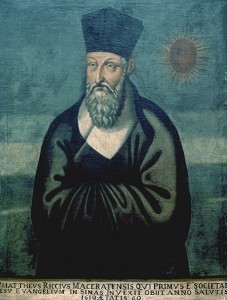Matteo Ricci (1552–1610)
Matteo Ricci was born into a noble Italian family in Macerata, Italy. He studied law in Rome but became more interested in the new science that was sweeping Western Europe. Entering the Society of Jesus in 1571, he continued his studies in philosophy, theology, mathematics, cosmology, and astronomy. Ricci was sent on a mission to Asia and in 1580 was sent by Alessandro Valignani, superior of Jesuit missions in the East Indies, to prepare to enter China.
In the Portuguese colony of Macau Ricci mastered the Chinese language and entered China in 1583 dressed first in the clothing of a Buddhist monk and then later as a Confucian mandarin. He brought with him Western clocks, musical instruments, mathematical and astronomical instruments, and cosmological, geographical, and architectural works with maps and diagrams. These, along with Ricci’s phenomenal memory and mathematical and astronomical skills, attracted an important audience among the Chinese elite.
After a decade of dialogue with members of the Chinese intelligentia, Ricci was called to meet with Emperor K’ang-Hsi in Beijing in 1601, the first western missionary to receive such an invitation. He became the court mathematician and remained in Beijing for the last nine years of his life. In 1602 , he published his “Great Map of Ten Thousand Countries,” a world map for China.
While in China Ricci wrote a Treatise on Friendship, a Treatise on Mnemonic Arts, a Chinese translation of Euclid’s Elements of Geometry, a book of Chinese apologetics—The True Meaning of the Lord of Heaven, and Ten Discourses by a Paradoxical Man. In addition, the journals that he kept and edited for publication allow one of the few glimpses of an outsider’s view of Chinese society and government during a period when China was closed to foreign visitors.
The website IgnatianSpirituality notes:
“After Ricci’s death certain of his decisions were questioned by Church authorities. Especially questioned was Matteo Ricci’s acceptance of Chinese ancestor worship as a legitimate, nontheological memorial to their ancestors that Catholic converts could practice. Later missionaries, not as schooled in Chinese culture, questioned this interpretation and brought their case to the Vatican. After decades of debate, in 1705 the Vatican decided that the Chinese practice of ancestor worship rites was incompatible with Catholic doctrine and was forbidden. Hearing this, the Chinese emperor banned Christian missions from China in 1721, closing the door that Ricci worked so patiently to open.”
I have drawn freely from this and several other articles for this brief overview of the fascinating life of Matteo Ricci. A wealth of information about Ricci is available on the Zhaoqing Ricci Center website. The University of San Francisco’s Ricci Institute for Chinese-Western Cultural History promotes Chinese-Western interaction in the spirit of friendship and respect exemplified by Ricci. An extensive article on Ricci and the Catholic Church’s deliberations with regards to Ricci’s mission can be read at the Catholic Encyclopedia site.

